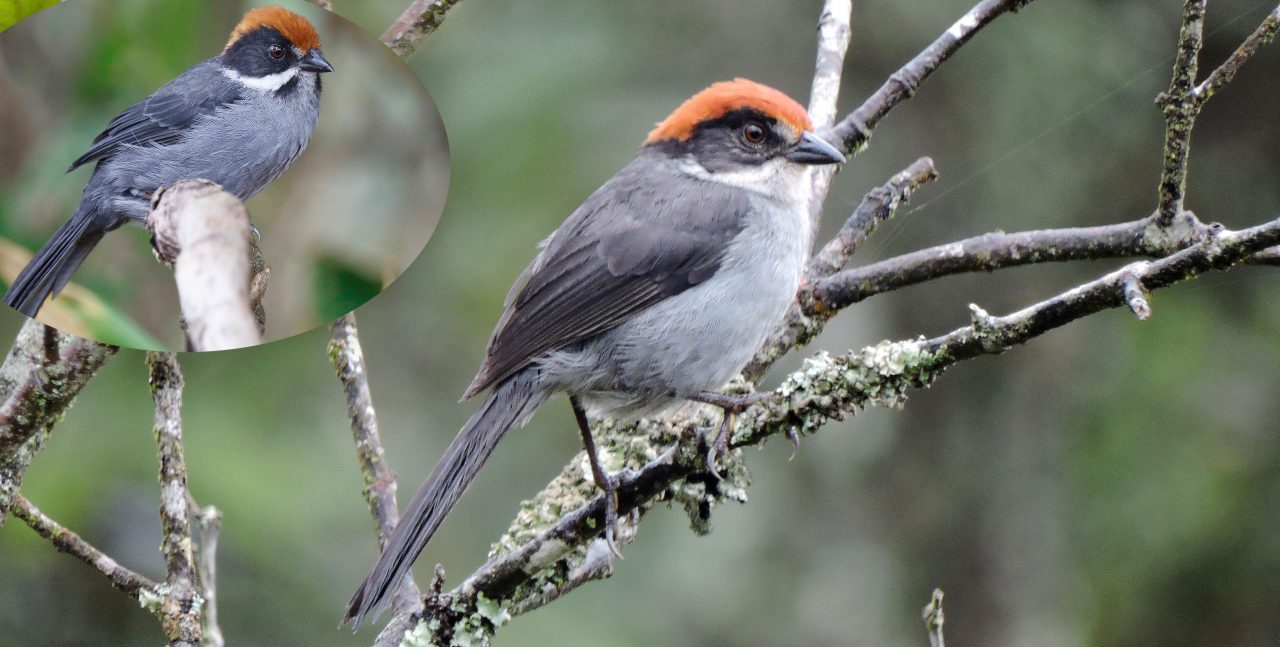In Colombia, A Sunday Bird Walk Turns Up a Species Thought Extinct
By Marc Devokaitis and Winny Sun
October 4, 2019

From the Autumn 2019 issue of Living Bird magazine. Subscribe now.
In a town in Colombia named for “Saint Peter of the Miracles,” one birder’s Sunday stroll to church took a turn for the miraculous—he discovered a bird thought to be extinct.
On January 7, 2019, Rodolfo Correa Peña was on his way to Mass in San Pedro de Los Milagros, a suburb of Medellín, when he spotted a group of brushfinches—finch-sized songbirds with heavy bills—hopping around in a neighbor’s vegetable garden. Peña, an engineering student with a burgeoning interest in birding, noted something odd about the markings and coloration of one of the birds.
“From the beginning I thought it was something different,” says Peña. “When I checked the field guide, it did not look like the other two brushfinches I know from my area, the Slaty Brushfinch and the Yellow-headed Brushfinch.”
Peña has been interested in birds and the natural world since his childhood on a family farm, and he knew his neighborhood birds. But he became a serious birder after friends introduced him to the Cornell Lab of Ornithology’s Global Big Day, a citizen-science birding blitz, in 2017.
“That event was like a baptism into birding. I saw how exciting it can be. I started paying more attention,” says Peña.
Peña snapped a picture of his mystery brushfinch, which he sent to Juan Parra, a biology professor at the local university. Parra sent it along to Sergio Chaparro-Herrera, an ornithologist with the Colombian national park system, who traveled with a colleague to San Pedro to investigate. Together with Peña and Parra, they relocated the bird and confirmed the identification: an Antioquia Brushfinch, a bird thought to be extinct that had only previously been identified by museum specimens. No scientist had ever seen and documented an Antioquia Brushfinch alive. Peña’s find was published in June in the journal Cotinga.


San Pedro de los Milagros is a town of about 30,000 people just north of the metropolis of Medellín, a city of nearly 4 million. Scientists were shocked that the bird was found in an urban area; previous searches for the species had focused mostly on remote forest habitat.
“All of us were surprised to find them in vegetable gardens, and so close to town,” says Chaparro-Herrera.
With the support of American Bird Conservancy and other partners, Chaparro-Herrera and his team have formed the Atlapetes Project (named for the brushfinch’s genus) to promote continued study of the bird. Already the team has found around 20 additional individuals in four distinct populations, and plans to place GPS tags on some birds to gain a better understanding of their behavior, range, and preferred habitat.
Early findings suggest the species is restricted to one broad plateau in northern Colombia. Through the additional research, the team determined that the species prefers scrub habitat with shorter trees and occurs regularly in rural farmland.
Dan Lebbin, vice president of threatened species with American Bird Conservancy, says that in many areas this kind of habitat is being cleared for crops and for grazing cattle to support the region’s thriving dairy industry.
“Despite the challenges, we are optimistic that the species can be saved from extinction,” says Lebbin. He says that a dual strategy of protecting remaining scrub habitat patches as reserves and restoring scrub habitat on agricultural working lands has great potential to foster Antioquia Brushfinch recovery.
Peña, the churchgoing birder who rediscovered the species, earned his engineering degree this summer, but is planning postgraduate studies integrating bird conservation and the sustainability of rural farms.
“This experience of rediscovery brought me closer to rural communities,” says Peña. “There are many opportunities through engineering to help farms lower their impact on natural spaces. I think the future of the conservation of many species, including the Antioquia Brushfinch, is in the hands of these small family farms.”
Winny Sun is a Cornell student editorial assistant. Her work on this story was made possible by the Cornell Lab of Ornithology Science Communication Fund, with support from Jay Branegan (Cornell ’72) and Stefania Pittaluga.


All About Birds is a free resource
Available for everyone,
funded by donors like you





